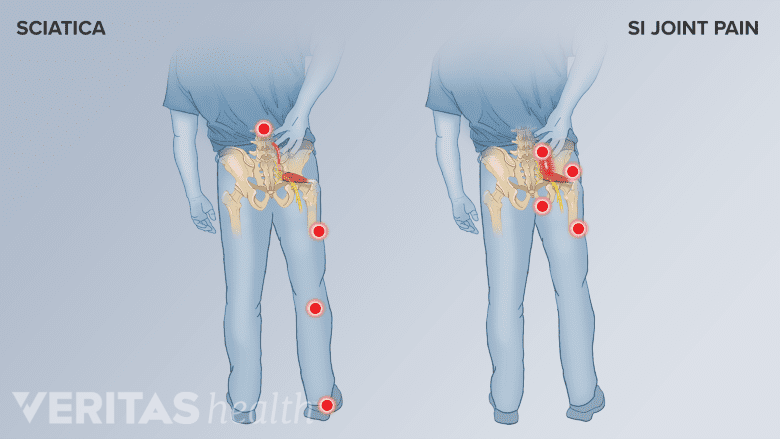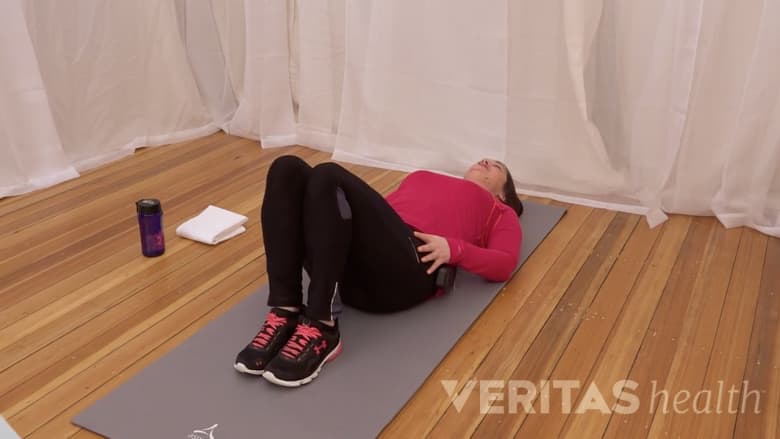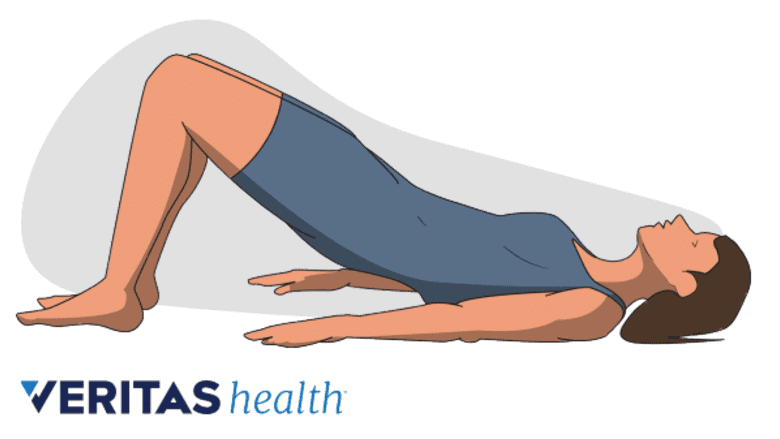Exercises that stabilize the sacroiliac joints in the pelvis can help minimize painful micro-motions that irritate the sciatic nerve. Additionally, stretches that reduce tension around the sacroiliac joint can help restore a natural range of motion and alleviate muscle tension that may be irritating the sciatic nerve and causing pain in the buttock and leg.
In This Article:
- Stretches and Exercise for Sciatic Pain from Piriformis Syndrome
- Sacroiliac (SI) Joint Exercises for Sciatic Pain
- Sacroiliac Joint Exercises for Sciatic Pain Relief Video
- 4 Easy Stretches For Piriformis Syndrome Pain Relief Video
Differences Between Sacroiliac Joint Dysfunction and Sciatica

Sciatica and sacroiliac joint dysfunction share similar symptoms but have distinct underlying causes.
Inflammation of the sacroiliac joint is believed to be caused by a disruption in the normal movement of the joint, despite the fact that the sacroiliac joint (also called the SI joint) naturally has a very limited range of motion. If the sacroiliac joint becomes inflamed or experiences too much or too little movement, the portion of the sciatic nerve that runs directly in front of the joint can be irritated.
Sacroiliac joint dysfunction affects the sciatic nerve and has similar symptoms to sciatica. However, pain along the sciatic nerve caused by sacroiliac joint dysfunction is not caused by a compressed nerve root as it exits the spine, as occurs with true sciatica.
Stretching Exercises for Sciatic Pain from Sacroiliac Joint Dysfunction
Performing range of motion exercises directed at the SI joint can restore normal movement and alleviate the irritation of the sciatic nerve. Three helpful exercises are described below:
Single knee-to-chest stretch

The single knee-to-chest stretch targets the SI joint and helps alleviate sciatic nerve irritation.
Lying flat on the back, with legs straight. Bend one knee, pulling it up to the chest and hold with both hands for 5 to 10 seconds. Repeat the stretch in the opposite leg 5 to 10 times.
Extension

The press-up stretch is a beneficial exercise for improving lower back strength and flexibility.
Lying on the stomach, press the body up on the elbows while the pelvis remains in contact with the floor. Keep the lower back and buttocks relaxed for a gentle stretch. Hold the press-up position initially for 5 seconds, and gradually work up to 30 seconds per repetition. Aim to complete 10 repetitions. For a more advanced stretch, press up on the hands.
Lumbar rotation - non-weight bearing

Lumbar rotation exercises can help improve SI joint mobility and reduce sciatica pain.
Starting by lying on the back with both knees bent, keep the feet flat on the floor and pull both knees to one side. The thighs should rub together, and the knees will not move very far. The lower back and shoulders should remain flat on the floor. Hold for 5 to 10 seconds, then complete this stretch on the other side.
For effective pain relief, stretches should be part of a regular routine and repeated twice daily. Sporadic or infrequent stretching is unlikely to effectively reduce tension in the pelvis or alleviate sciatic pain. The above stretches may be included as part of a physical therapy program with instructions to complete at home.
Strengthening the Sacroiliac Joint for Sciatica Relief
The following exercises can help strengthen the pelvic muscles, stabilize the sacroiliac joint, and reduce excess motion that aggravates the sciatic nerve:
Bridge

Bridge exercise strengthens the core muscles.
Lying on the back with both knees bent and arms straight at the sides, slowly raise the hips off the floor so the body is straight from the knees to the shoulders. Hold this pose for 5 seconds, then slowly lower the hips back to the floor. Repeat 8 to 10 times.
Bird-dog pose

Bird dog exercise strengthens core muscles, enhancing stability and balance.
Start on all fours, in a 4-point position, with hands and knees positioned under the shoulders and hips, respectively. Raise one arm straight in front of the body and the opposite leg straight behind, and hold this pose for 5 seconds. Complete 3 to 5 repetitions on each side of the body.
These strengthening exercises may be included as part of a physical therapy program, or may be recommended by a doctor and completed at home. It is important to consult with a doctor if pain occurs, or if guidance is needed to complete the exercises with appropriate and effective form.

